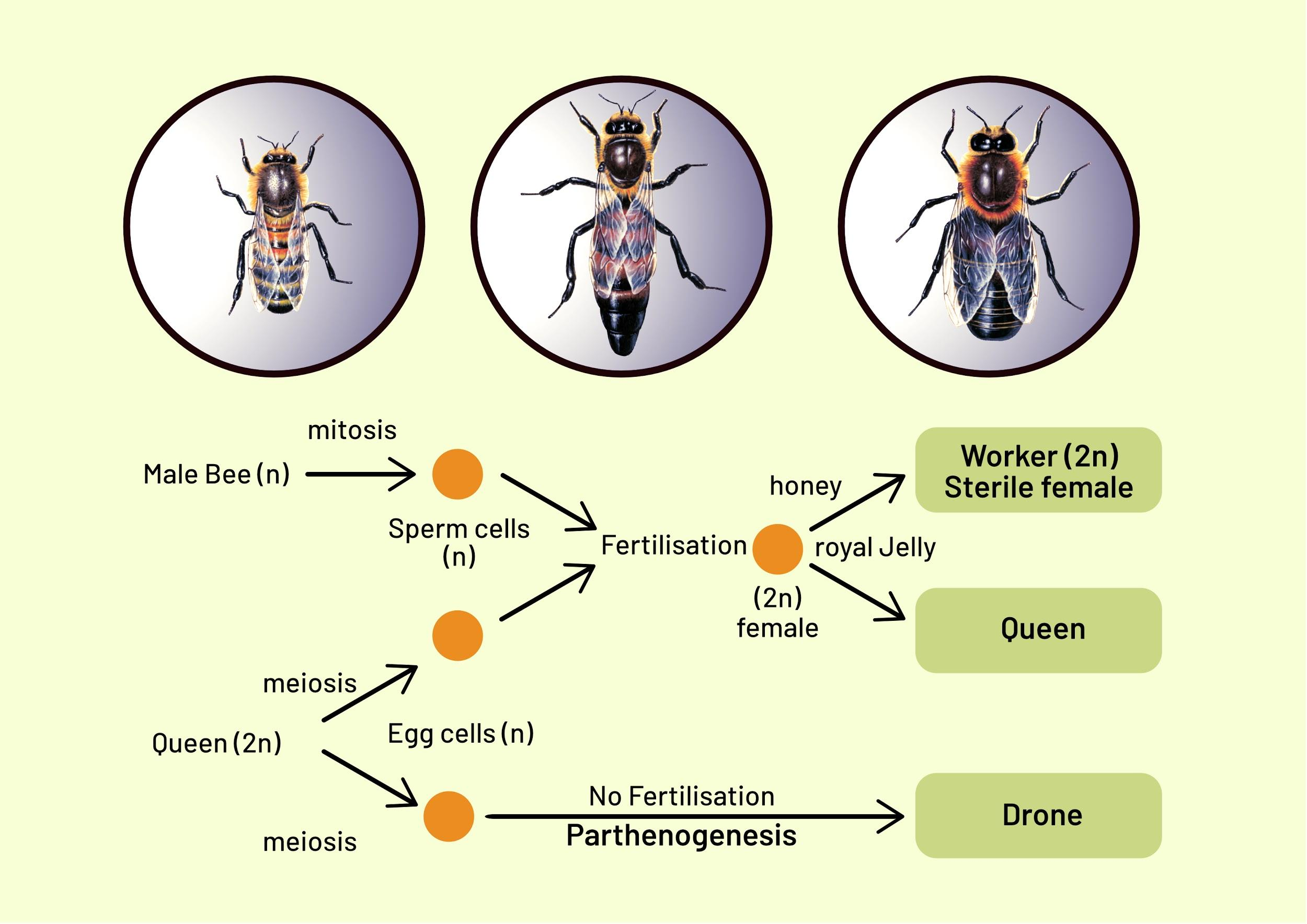
Haploid parthenogenesis among insects is shown by order
(a)Hymenoptera
(b)Homoptera
(c)Coleoptera
(d)All of the above
Answer
554.7k+ views
Hint: In haploid parthenogenesis, haploid eggs produce haploid adults. It occurs in species of nematodes, bees and plant offsprings. The organism produced by haploid parthenogenesis for other participants in bisexual reproduction.
Complete answer:
Hymenoptera shows haploid parthenogenesis among insects. It is a method of reproduction by which the unfertilized egg develops into an embryo without the process of fertilization which can result in haploid and diploid parthenogenesis. Some females produce eggs that undergo reductional division that results in eggs with a haploid number of chromosomes. Hymenoptera is crucial to humans as they are pollinators of wild and cultivated flowers and act as parasites of destructive insects. They act as makers of honey. This order includes the best known social insects which are the insects and some special species of bees and wasps. They show dance-like movements of honey bees and communicate from one individual to another for the location, quantity, distance, and quality of a particular source of food.
Additional Information: Homoptera: It consists of more than 32000 species of sucking insects. They vary in body size. They are plant feeders that consist of mouthparts. They are adapted for sucking plants sap from a wide assortment of trees. They are wild and cultivated plants. Some species can cause injuries to the plant which includes fruit trees and grain crops. Some provide secretions or other products that are beneficial and have commercial value.
Coleoptera: Order Coleoptera includes the group of insects which are beetles. They are the largest of all the orders as they consist of about 40% of insects and about 25% of known animal life forms some of which are discovered frequently. They interact with the ecosystem from almost every habitat which includes the polar region but except the sea. They feed on some plants and fungi. Some are agricultural pests whereas some breakdown animals and plant debris and eat other invertebrates.
So, the correct answer is 'Hymenoptera'.

Note: Coleoptera is the largest order with almost 300000 species and is still to be discovered. The aquatic beetle Whirligig consists of two pairs of eyes. Every species of Hymenoptera consists of mouthparts. They are active on warm sunny days and come out only at night. Hymenopterans which live in colonies are social and they eat pollen and nectar.
Complete answer:
Hymenoptera shows haploid parthenogenesis among insects. It is a method of reproduction by which the unfertilized egg develops into an embryo without the process of fertilization which can result in haploid and diploid parthenogenesis. Some females produce eggs that undergo reductional division that results in eggs with a haploid number of chromosomes. Hymenoptera is crucial to humans as they are pollinators of wild and cultivated flowers and act as parasites of destructive insects. They act as makers of honey. This order includes the best known social insects which are the insects and some special species of bees and wasps. They show dance-like movements of honey bees and communicate from one individual to another for the location, quantity, distance, and quality of a particular source of food.
Additional Information: Homoptera: It consists of more than 32000 species of sucking insects. They vary in body size. They are plant feeders that consist of mouthparts. They are adapted for sucking plants sap from a wide assortment of trees. They are wild and cultivated plants. Some species can cause injuries to the plant which includes fruit trees and grain crops. Some provide secretions or other products that are beneficial and have commercial value.
Coleoptera: Order Coleoptera includes the group of insects which are beetles. They are the largest of all the orders as they consist of about 40% of insects and about 25% of known animal life forms some of which are discovered frequently. They interact with the ecosystem from almost every habitat which includes the polar region but except the sea. They feed on some plants and fungi. Some are agricultural pests whereas some breakdown animals and plant debris and eat other invertebrates.
So, the correct answer is 'Hymenoptera'.

Note: Coleoptera is the largest order with almost 300000 species and is still to be discovered. The aquatic beetle Whirligig consists of two pairs of eyes. Every species of Hymenoptera consists of mouthparts. They are active on warm sunny days and come out only at night. Hymenopterans which live in colonies are social and they eat pollen and nectar.
Recently Updated Pages
Master Class 12 Social Science: Engaging Questions & Answers for Success

Master Class 12 Physics: Engaging Questions & Answers for Success

Master Class 12 Maths: Engaging Questions & Answers for Success

Master Class 12 Economics: Engaging Questions & Answers for Success

Master Class 12 Chemistry: Engaging Questions & Answers for Success

Master Class 12 Business Studies: Engaging Questions & Answers for Success

Trending doubts
What are the major means of transport Explain each class 12 social science CBSE

Which are the Top 10 Largest Countries of the World?

Draw a labelled sketch of the human eye class 12 physics CBSE

How much time does it take to bleed after eating p class 12 biology CBSE

Explain sex determination in humans with line diag class 12 biology CBSE

Plot a graph between potential difference V and current class 12 physics CBSE




